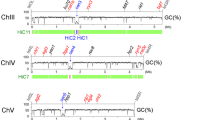Abstract
Telomeres are the sequences that form the ends of eukaryotic chromosomes and are essential structures that confer genome stability and guide chromosome behavior. In addition, the terminal regions of the chromosomes tend to house genes with predicted roles in ecological adaptation. Unfortunately, however, most fungal genome assemblies contain very few telomeres and, therefore, the identities of genes residing near the chromosome ends are often unknown. In an effort to develop a complete understanding of the organization and gene content of chromosome ends in a number of fungi, we developed efficient methods for the identification and targeted cloning of telomeres. This chapter describes the basic steps and shows exemplary results from the targeted cloning of Epichloë festucae telomeres.
Access this chapter
Tax calculation will be finalised at checkout
Purchases are for personal use only
Similar content being viewed by others
References
Bass, H.W., Reiera-Lizarazu, O., Ananiev, E.V., Bordoli, S.J., Rines, H.W., Phillips, R.L., Sedat, J.W., Agard, D.A. and Cande, W.Z. (2000) Evidence for the coincident initiation of homolog pairing and synapsis during the telomere-clustering stage of meiotic prophase. J. Cell Sci., 113, 1033–1042.
Niwa, O., Shimanuki, M. and Miki, F. (2000) Telomere-led bouquet formation facilitates homologous chromosome pairing and restricts ectopic recombination in fission yeast. EMBO J., 19, 3831–3840.
Tomita, K. and Cooper, J.P. (2007) The telomere bouquet controls the meiotic spindle. Cell, 130, 113–126.
Chikashige, Y., Ding, D.Q., Funabiki, H., Haraguchi, T., Mashiko, S., Yanagida, M. and Hiraoka, Y. (1994) Telomere-led pre-meiotic chromosome movement in fission yeast. Science, 264, 270–273.
Farman, M.L. and Kim, Y.-S. (2005) Telomere hypervariability in Magnaporthe oryzae. Mol. Plant Pathol, 6, 287–298.
Horowitz, H., Thorburn, P. and Haber, J.E. (1985) Rearrangements of highly polymorphic regions near telomeres of Saccharomyces cerevisiae. Mol. Cell. Biol., 4, 2509–2517.
Wada, M. and Nakamura, Y. (1996) Antigenic variation by telomeric recombination of major-surface-glycoprotein genes of Pneumocystis carinii. J. Euk. Microbiol., 43, 8S.
Cuomo, C.A., Guldener, U., Xu, J.R., Trail, F., Turgeon, B.G., Di Pietro, A., Walton, J.D., Ma, L.J., Baker, S.E., Rep, M. et al. (2007) The Fusarium graminearum genome reveals a link between localized polymorphism and pathogen specialization. Science, 317, 1400–1402.
Kasuga, T., Mannhaupt, G. and Glass, N.L. (2009) Relationship between phylogenetic distribution and genomic features in Neurospora crassa. PLoS One, 4, e5286.
Barry, J.D., Ginger, M.L., Burton, P. and McCulloch, R. (2003) Why are parasite contingency genes often associated with telomeres? Int. J. Parasitol., 33, 29–45.
Wada, M. and Nakamura, Y. (1996) Unique telomeric expression site of major-surface-glycoprotein genes of Pneumocystis carinii. DNA Research, 3, 55–64.
Schaffzin, J.K. and Stringer, J.R. (2004) Expression of the Pneumocystis carinii major surface glycoprotein epitope is correlated with linkage of the cognate gene to the upstream conserved sequence locus. Microbiology, 150, 677–686.
Li, W., Rehmeyer, C.J., Staben, C. and Farman, M.L. (2005) TERMINUS:Telomeric-end read mining in unassembled sequences. Bioinformatics, 21, 1695–1698.
Rehmeyer, C., Li, W., Kusaba, M., Kim, Y.-S., Brown, D., Staben, C., Dean, R. and Farman, M. (2006) Organization of chromosome ends in the rice blast fungus, Magnaporthe oryzae. Nucleic Acids Res., 34, 4685–4701.
Wu, C., Kim, Y.-S., Smith, K.M., Li, W., Hood, H.M., C., S., Selker, E.U., Sachs, M. and Farman, M.L. (2009) Characterization of chromosome ends in the filamentous fungus Neurospora crassa. Genetics, 181, 1129–1145.
Henderson, E.R. and Blackburn, E.H. (1989) An overhanging 3’ terminus is a conserved feature of telomeres. Mol. Cell. Biol., 9, 345–348.
Michaels, S.D., John, M.J. and Amasion, R.M. (1994) Removal of polysaccharides from plant DNA by ethanol precipitation. Biotechniques, 17, 274–276.
Acknowledgments
I would like to acknowledge the technical support of David Thornbury. The development of these methods was supported by grants MCB 0653930 and EF 0523661 from the National Science Foundation.
Author information
Authors and Affiliations
Corresponding author
Editor information
Editors and Affiliations
Rights and permissions
Copyright information
© 2011 Springer Science+Business Media, LLC
About this protocol
Cite this protocol
Farman, M.L. (2011). Targeted Cloning of Fungal Telomeres. In: Xu, JR., Bluhm, B. (eds) Fungal Genomics. Methods in Molecular Biology, vol 722. Humana Press. https://doi.org/10.1007/978-1-61779-040-9_2
Download citation
DOI: https://doi.org/10.1007/978-1-61779-040-9_2
Published:
Publisher Name: Humana Press
Print ISBN: 978-1-61779-039-3
Online ISBN: 978-1-61779-040-9
eBook Packages: Springer Protocols




